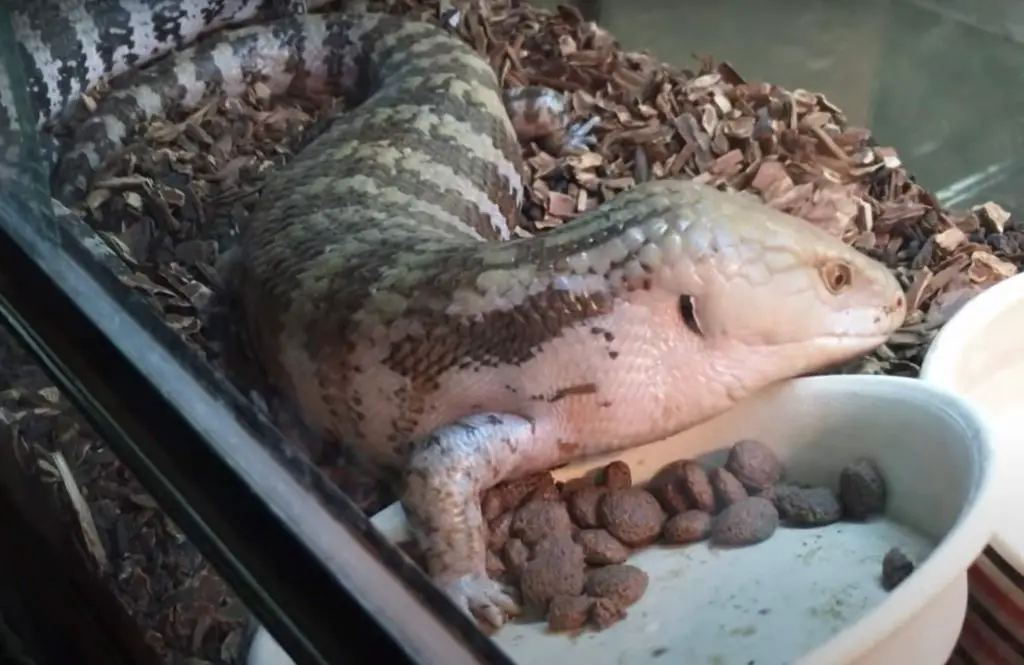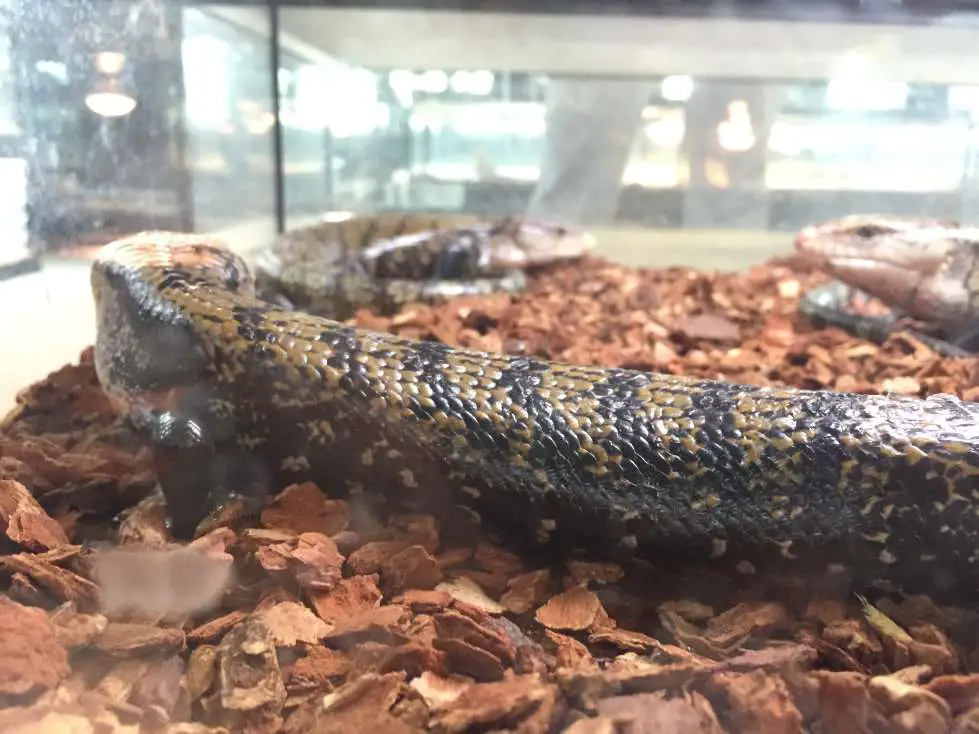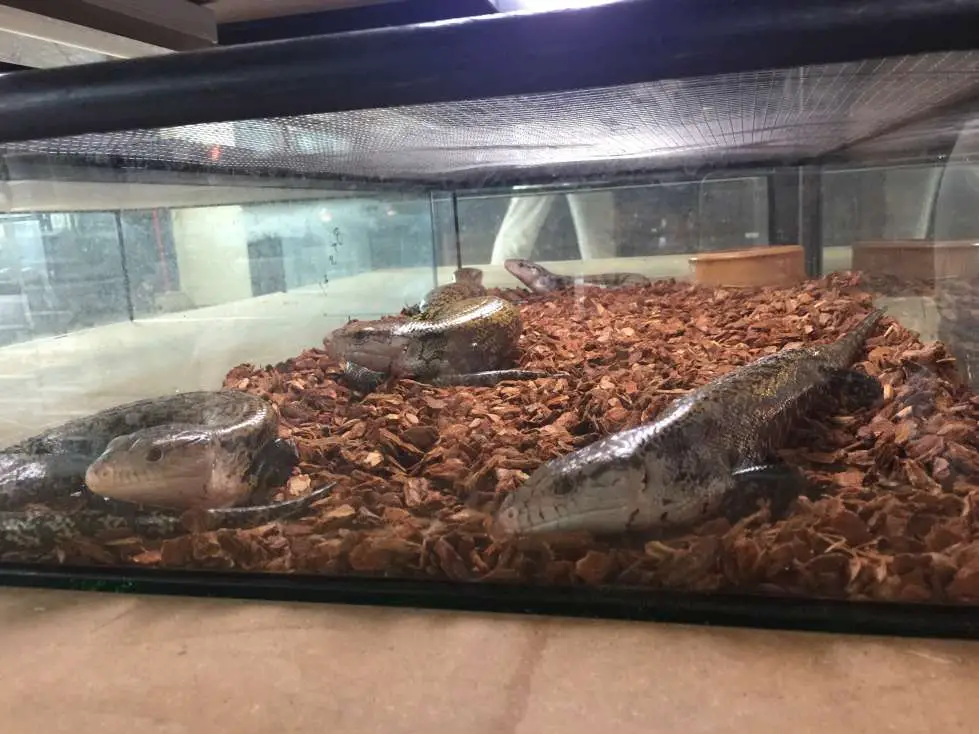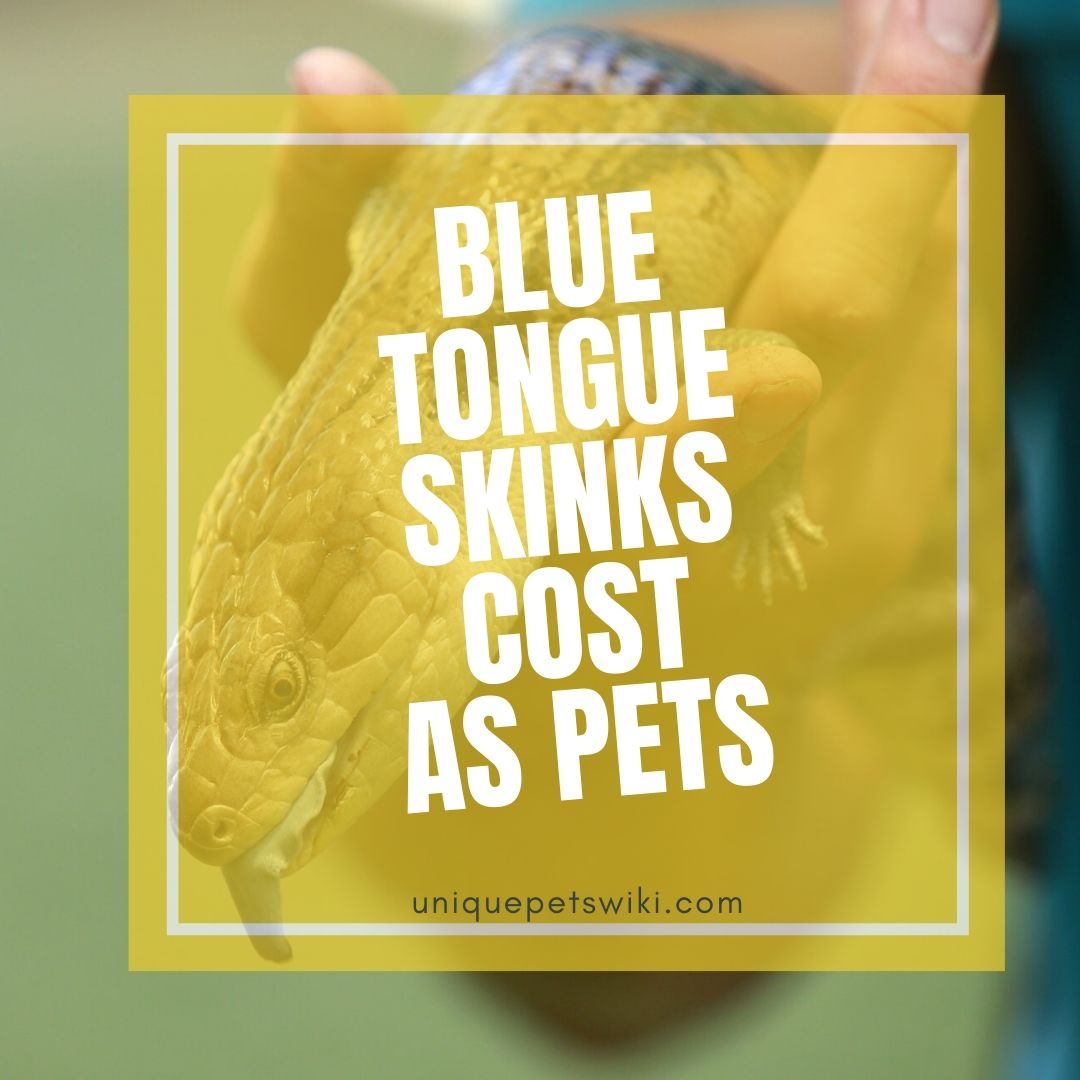How much do blue tongue skinks cost as pets? The cost to own blue tongue skinks and caring for one is based on the species, age, look, and morphology of the skink.
Adult blue tongue skinks will cost higher than baby blue tongue skinks. The same price applies to lineage. On average, blue tongue skinks cost from $150 to a few hundred USD. Less common species, such as Hypo Merauke morph, will cost for $5000 or higher.
The base price for blue tongue skinks also depends on their sex. Usually, a female will cost 20%-30% higher than male blue tongue skinks.
The maintenance costs for blue tongue skink is around $40/monthly for one species.
The more common a blue tongue skink species, the lesser the price for it. On the contrary, the rarest blue tongue skink species and most beautiful morphs are costly.
The goal of this article is to give you a deep insight into blue tongue skink prices.
Contents
Blue Tongue Skinks Cost List

| Cost | Cost type | |
| Indonesian Blue Tongue Skinks Cost | Price range: $150-$400 | Common Species Cost |
| Australian Blue Tongue Skinks | Price range: $150-$975 | Common Species Cost |
| Centralian and Shinglebacks blue tongue skinks | As price of $5000 | Rare Species Cost |
| Food & health care | $40/month | Maintenance cost |
We list the prices for Indonesian Blue Tongue Skink and Australian Blue Tongue Skinks morphs below.
The prices are recored in 2020 after checking the prices from multiple sellers and breeders.
Indonesian Blue Tongue Skinks Cost ($150-$400)
Indonesian blue tongue skinks are scientifically called Tiliqua Gigas, mostly found on Indonesia Islands.
These skink subspecies are typically caught in the wild since wildlife exportation from Indonesia is not illegal, and they are generally less expensive.
1.) Merauke Blue Tongue Skink
Merauke is ideal for beginners who aren’t experienced in reptiles because they appear calmer in disposition than other species.
These skinks species are easy to get, and their price may vary depending on the market you’re getting it from. But on average, they will cost about $200-$350 at morphmarket.com.
2.) Tanimbar Blue Tongue Skink:
Tanimbar blue tongues are one of the most beautiful looking species. They are not large in size. They rarely grow to a length of 18 inches in adulthood. These species of skinks price range would be around $150.
3.) Kei Island Blue Tongue Skink:
These Indonesian blue tongue skinks, as listed for sale on morphmarket.com, are sold for $375.
4.) Classic Indonesian Blue Tongue Skink:
The classic Indonesian blue tongue skinks measure 50cm in full length and are sold for $200.
5.) Irian Jaya Blue Tongue Skink:
These are one of the rarest species of skinks. They cost between $250-$400.
6.) Halmahera Blue Tongue Skink:
The Halmahera skinks are long, lean, and whippy looking skinks. They are the third smallest in size after Pygmy and Classic Indonesian skinks.
Baby Halmaheras are sold for at most $200 at morphmarket.com, while the adults’ price varies, ranging from $200-$369.
Australian Blue Tongue Skinks Cost
The Australian Blue Tongue Skinks is the largest and most common subspecies of skinks. One characteristic of Australian SKINKS is its high-temperature requirements.
Australian blue-tongue skinks need mild temperatures with an atmospheric temperature of 75-85 degrees Fahrenheit and a basking spot of 95°F.
Because Australian species are very hard to obtain in the US due to strict import rules, they primarily exist as captive-bred and are quite expensive.
1.) Northern Blue Tongue Skink:
Northern blue tongue skinks range in price from $150 to $250 for babies and $649 for adults. Highly colored or rarer morphs like T+ Albino and Caramel cost more between $649 to $700.
- Sunrise Caramel Northern
This skink is completely white in color with light patterning that can be red or yellow. It is a combination of sunrise and caramel morphs of Northern blue tongue skink. Its composition is 75% sunrise and 25% caramel.
Depending on the sizes and coloration, Sunrise Caramel Northerns are listed for sale at Adam Chesla Reptile, with prices ranging from $850 to $975.
2.) Eastern Blue Tongue Skink:
Eastern blueys are large in size like the Northerns. Adult Eastern skinks are sold for $400
3.) Western Blue Tongue Skink:
Western blueys aren’t common to find. They are listed on some online markets for $550.
4.) Adelaide Pygmy Blue Tongue Skink:
The pygmy blue tongue skinks are the smallest of all the skinks. They are not common species of skinks. On average, pygmy blue tongue skinks cost $100.
Prices are not easily available for the rarest species such as Shinglebacks, Centralian, and other morphs. Several breeders and retailers opted not to disclose the prices of most of their Australian blue tongue skinks other than the Northerns.
Maintenance Costs Of Blue Tongue Skinks
Before discussing costs to maintain a blue tongue skink, you need to know that care for a blue tongue skink is not too difficult. However, it requires basic knowledge about blue tongue skink care.
I would recommend you to get a good blue tongue skink book. Not to become an expert on blue tongue skink care but will help you avoid new skink owners’ common mistakes.
Last update on 2023-01-02 / Affiliate links / Images from Amazon Product Advertising API
Although maintenance costs add up to a blue tongue skink’s overall costs, the main price determinants are the species, coloration/patterning, age, size, and availability in the market. Maintenance costs only happen to be secondary.
In this section, we’ll briefly look at the costs of getting and caring for blue tongue skinks for beginners.
How much it’ll cost you to get and maintain a blue tongue skink depends entirely on your choices. However, the initial setup will be a bit expensive, depending on the skink species you buy and how you choose to house it.
If you go ahead to give your skinks over-furnished enclosures, then it will cost you more. But you will save a lot if you decide to get used goods and shop light bulbs and fixtures from a local store like Home Depot.
It might also interest you to know that it cost less to care for a lot of skinks than to maintain just one.
For instance, two breeders who spend every month a total of $80 on 20 skinks and $65 on 5 skinks spend less in terms of average maintenance cost on each skink than another breeder that spends $30 on everything for just one skink.
Below are the average maintenance costs of each item you’ll need for your skinks.
Enjoy the deal up to 60% for blue tongue accessories
Last update on 2022-12-29 / Affiliate links / Images from Amazon Product Advertising API
Food

On dieting, blue tongue skinks feed on several plants as well as animal foods. Their blue tongue skinks diet consists of 50% fresh vegetables, 40% animal food (protein), and 10% fresh fruits. This is the right proportion for a healthy diet, and offering your skinks, a variety of foods will help them not to become picky eaters.
The amount of food you need to feed to your skinks depends on their size and age. In general, it’s best to feed baby skinks and young skinks as much as possible and as often as they want over a six-day cycle, with a rest on the seventh day. You can offer fresh food to adult skinks every single day interval.
Foods such as legumes, green leaves, green beans, squash, carrots, parsnips, strawberries, bananas, melons, low-fat canned dog/cat food, super worms, pinkie mice are quite perfect for blue tongue skinks.
These food items can be locally sourced to save money. In a month, if you’re not going too far to spoiling your skinks with food, the average you would spend on food is $30 for 1-5 skinks.
They are omnivorous and can adapt to any food readily available, making them a bit less expensive to care for than bearded dragons.
Please note that blue tongue skinks should not be given foods such as lettuce, spinach, acidic citrus fruits, avocados, and rhubarb as these foods are highly toxic to their body system and may cause diarrhea.
Vitamins And Calcium Powder Supplements

As with every other reptile, blue-tongue skinks need supplements in their diet. One, to develop strong bones and muscles and, two, for their general wellbeing.
What distinguishes skinks from other reptiles is the quantity and how often they require supplementation.
Blue tongue skinks have a wide variety of foods enriched with nutrients, and as such, may be minimally dependent on supplementations.
However, if you do not balance your blue tongue skink diet or the lighting and heating is not enough, supplementation is vital. Calcium powder, in particular, is fortified with vitamin D3.
You can trust the best Calcium powders are products from Zoo Med, Rep-Cal, Flukers, and Exo Terra.
Supplements from each of these brands cost around $15 to $20. The prices vary depending on the brand and size of the products.
Last update on 2022-12-29 / Affiliate links / Images from Amazon Product Advertising API
Costs for other Accessories

Certain housing accessories that you need to take good care of your skinks include enclosures, lighting/heating, and other housing accessories like logs, cork bark, basking stone, Mopani wood, hide boxes, and substrates.
New to blue tongue skink? Check out the blue tongue skink care sheet now! We had listed out all the things you need to know about blue tongue skinks as pets. Check it now!
These items are essential for the enrichment of your skinks. Since skinks love to hide as part of their burrowing nature, you’ll need one cool, dry, and warm moist hide to help them feel comfortable.
The logs and large cork barks in their enclosures make for excellent hides and climbing exercises. Place each of the hide boxes or holes on each side of the enclosure (cool side and warm side) with some sphagnum moss inside to keep it moist.
These items will cost you about $50 on average to set up. Products from some expensive brands like ‘Terra Firma and Terra Fauna from Alice Springs’ may cost around $75 to $115.
However, to save some money, you can source rocks or wood locally from outside. Just make sure you sterilize the rocks by baking at 200-250°F for 2-3 hours, soaking the collected wood in a Nolvasan solution or boiling vinegar.
costs for Blue tongue Skink Substrates
Blue tongue skinks are burrowing lizards, requiring 4-6 inches of deep, soft, loose substrate.
The type of substrate you need depends on the species of your skinks. Below is a breakdown of the kind of substrate you should get based on species.
Australian blue tongue skinks
For Australian blue tongue skinks, we recommend substrates such as Reptichip, Lugarti Natural Reptile Bedding, or a semi-arid DIY mixture (this you can prepare it yourself by mixing 60% organic topsoil + 40% play sand).
Indonesian blue tongue skinks
Ideal substrates for Indonesian blue tongue skinks include Reptichip, sugar cane mulch, sphagnum moss, and a moist DIY mixture. (To prepare this, mix 40 percent organic topsoil + 40 percent Zoo Med ReptiSoil + 20 percent play sand).
These substrates would cost from $10 to $33, depending on the brand and quantity. Zoo Med costs $32 while Reptichip sells on Amazon for $27.
Substrates to avoid
As a matter of caution, note that products such as sand, refresh rodent bedding, and fir/pine/cedar wood products are inadequate when it comes to satisfying the humidity needs of your skinks.
These products can pose a serious health threat to blue tongue skinks, and because of that, they’re not recommended as substrates for skinks.
Other recommended products (materials) for use as substrates include newspaper, aspen shavings, and cypress mulch. Cypress mulch is especially suitable for dry climates when blended with humid sphagnum moss. Cypress mulch can be obtained for as low as $8.
Ideally, as part of caring for your blue tongue skinks, you need to change substrates monthly or at most every two months. While the bulbs every six months or yearly.
You can opt to have customized reptile enclosures for your skinks if you wish. This kit comes with all the necessary enclosure accessories for your skinks’ enrichment and offers a beautiful zoo-quality habitat for your skinks. But it is way too expensive. That alone will cost you about $390-$466.
In a nutshell, the list of items needed as a starter for breeding blue tongue skinks include:
- 48″x24″x24″ front-opening enclosure
- Halogen heat bulb
- Food dish (medium size)
- 8.5″ dome lamp with dimmable switch
- Basking stone (flat or any shape)
- Enrichment items: cork bark/logs, plants, etc.
- Hide/cave/box (x2)
- 4-6″ of substrates (bedding)
- Reptichip
- Calcium supplement (especially with vitamin D3)
- Large shallow water dish
- Multivitamin supplement
- Infrared temperature gun
- 22″ T5 HO 10-12% UVB bulb
- Natural Reptile Bedding
- 24″ T5 HO reflective UVB fixture
- Sphagnum moss
- Power strip with programmable digital timer
- Digital thermometer/hygrometer
- Reptile humidifier (for Indonesian species)
All these items will cost approximately $700.
One other cost to bear in mind is the vet bills. This is where the huge expense is. In the course of caring for your skinks, you may never have to take your skinks to a vet, but you still need to be prepared in case something unexpected happens.
On average, seeking the services of a veterinarian will cost you around $100.
Conclusion
How much do blue tongue skinks cost? $150 to over $5000 (2021 prices update)
Furthermore, it’s also important to know that you cannot buy a species without a verified license to prove that you’re eligible to own a blue tongue skink.




Where can I buy a cheap BTS?
Hi Cua, you can buy a blue tongue skink at morphmarket.com. If you are not staying in the US, you can pick the oversea transport option.